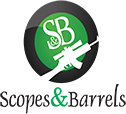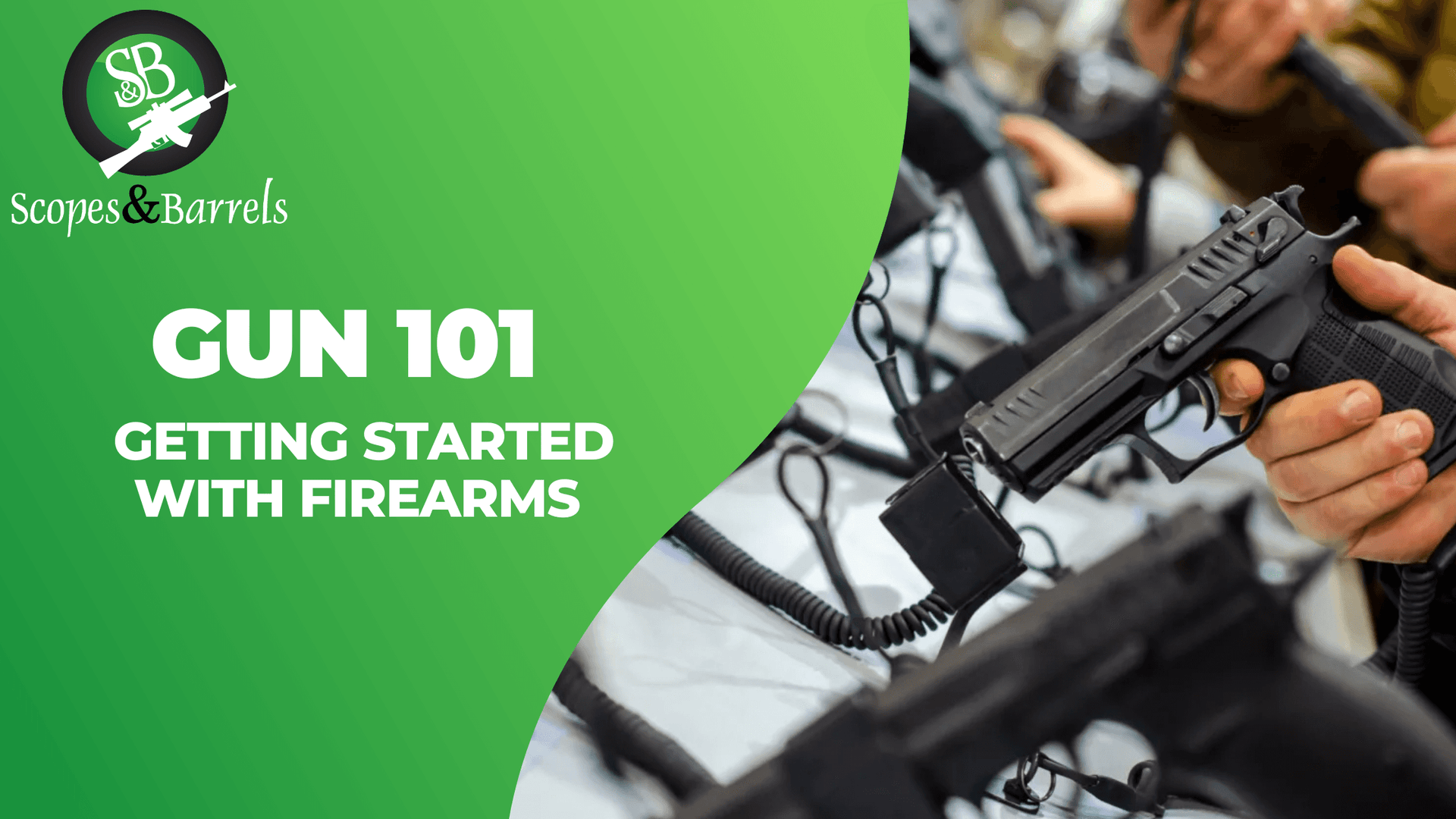So, you’re finally here!
Which can only mean you are deciding to purchase your first gun and are looking to learn the basics about firearms to help in your purchase.
That’s awesome! We are so glad you’re here because this blog is just written with keeping you in mind.
At the start, most people are nervous about buying a firearm as they are worried about being unsafe which is not wrong, being concerned about safety is a great thing.
But wait, you're here to get into and learn about firearms! So let us show you the basics of handling, shooting, and storing firearms.
In this Gun 101 article, we’re going to cover the basics of firearms for those new to guns:
- Firearm Safety
- Basic Gun Parts/Terms
- How Guns Work
- Choosing the Right Firearm
- How to Purchase Firearms
BASICS OF FIREARM SAFETY
You must be impatiently waiting to know how to pick the perfect gun for yourself or how to go out & practice shooting your firearm. Contain your excitement just for a little while because first we’re going to talk about something that is MUCH more important: Firearm Safety
Safe handling of firearms is of UTMOST priority! Firearms, by their nature, can be dangerous and deadly, hence they must be treated with respect and these rules should always be followed.
There are 4 basic rules of firearm safety. The first three rules apply to handling firearms and the fourth rule applies to the use of firearms while shooting. This blog separates the rules for handling firearms to help remind you that they apply every time you are around a firearm and not just while you are at the range.
Handling Firearms
#1 – Always Point The Firearm In The Safest Direction
You should NEVER point a loaded or unloaded firearm towards anything that you are not willing to shoot.
Although not pointing a firearm at anyone is great, but it doesn’t mean that any other direction is fine. For example, you may not want to shoot your TV, or worse, shoot through a wall and injure someone on the other side.
There may be no 100% safe direction in your particular situation, even shooting concrete below your feet might cause injuries but you need to be aware of the SAFEST direction at all times and be careful when watching others handle firearms.
#2 – Keep Your Finger Off The Trigger Until You Are Ready To Shoot
“Ready to shoot” means that the gun is pointed towards the target and you are about to shoot. This rule is easiest taught with a training device/non-firearm. We have a collection of Air pistols you can use to train on before trying your luck with an actual firearm => Airpistol – Scopes and Barrels
Have the new shooter practice on and handle a non-firearm (presumably Air pistol) until they subconsciously develop the habit of keeping their finger not only off the trigger, but also positively aligned with the firearm’s frame.
#3 – Treat All Guns As If They Are Loaded
This is the most important rule 🚨
“Never do anything with a firearm while using the excuse, ’don’t worry, it’s not loaded.’”
Treat every firearm with respect and as if it is loaded.
Never solely rely on a firearm’s safety “on”. This is because mistakes can happen when shooters rely only on a gun’s “safety” as a safety device.
Firearm safeties are mechanical devices that can fail. Also, relying on a safety alone often encourages shooters to break one of the rules. For example, “yes, I’m pointing my gun at you but don’t worry, the safety is on” is an unacceptable excuse for poor firearm handling.
Firearm Use
#4 – Be Mindful Of Your Target And It's Surroundings
Every bullet that leaves your firearm is your responsibility – regardless of where it travels.
Once you fire a bullet, you can never bring it back!
Always make sure your target is set up properly and be mindful of your surroundings to ensure the consequences are not tragic incase the bullet misses the target.
BASIC GUN PARTS/TERMS
It’s easy to get jumbled up on all of the little parts and names, but here’s the main stuff you should know before going on to make your first purchase:
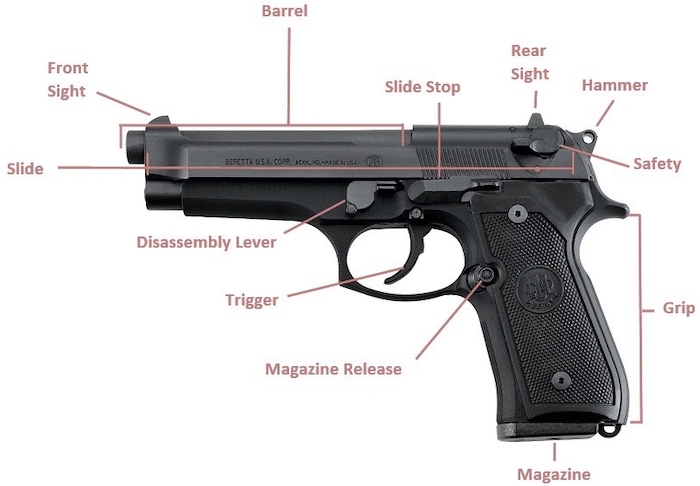
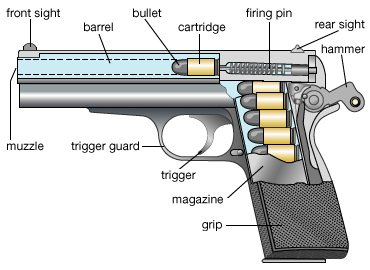

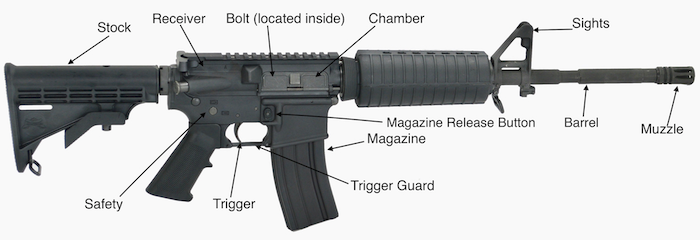
How Guns Work
By “creating an explosion in a tight space with only one way to escape”.
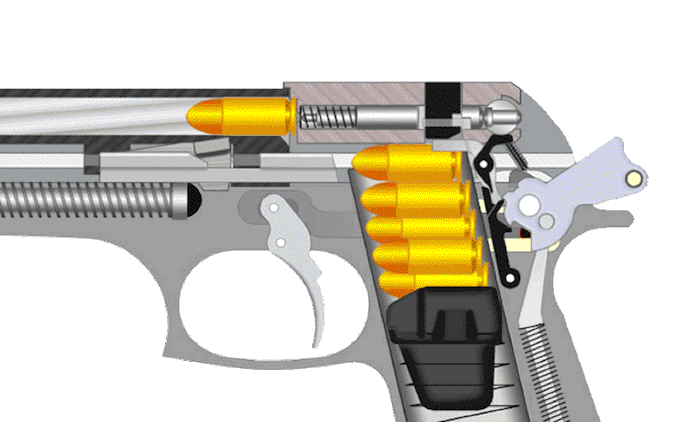
When you pull the trigger, a mechanical striker/firing pin hits the primer on the bottom/back of a round, this sparks the explosion inside the casing. The explosion then pushes against the back of the bullet forcing it to separate from the casing.
That energy keeps building as it continues pushing down the barrel. This allows room for the leftover burning gas to come out of the end of the barrel resulting in “muzzle flashes” or small flames.
This energy buildup is the reason why bullet speed and barrel length are often correlated. The more time a bullet and the gas/energy behind it are kept in that one-way-escape tube (barrel), the more time the bullet has to gain speed (and stability) before the energy is dispersed in the air.
CHOOSING THE RIGHT FIREARM
The right firearm is the one that best fits your need or intended purpose for the firearm.
We are often asked “what kind of gun should I get?”
Our answer to this comes in the form of informing the customer that there is no set standard for the right firearm. Just like when choosing a car or any other personal product, preference plays an important role - same is applied when purchasing a firearm with preference for size, brand and caliber varying from buyer to buyer.
Firearm Type
There are three main types of firearms that we’re going to discuss here: Rifles, Shotguns, and Handguns.
Rifles are shoulder fired weapons with spiral grooves in the barrel which spin the bullet to help stabilize its flight. Rifles are typically higher powered than handguns but they always have a butt-stock to place in your shoulder for support while firing.

The most common type of rifles are:
- Bolt-action rifles, these are popular for hunting and long range target shooting.
- Semi-automatic rifles, these are popular for target shooting, competitions, defense, and hunting.
There are many more types of rifles, but in this article we are just helping you get started with Firearms remember?
To learn more about rifles, stay connected with us on our Blogs page!
Handguns are firearms that are designed to be able to be fired with one hand - although use of both hands is preferred while handling a handgun.
The two most popular types of handguns are:
- Revolvers (think about a cowboy’s gun)
- Semi-auto pistols which hold ammunition in a magazine (typically in the grip of the pistol)
The most popular revolvers are made by Smith and Wesson and Ruger whereas there are many manufacturers of semi-auto pistols that are popular such as Glock, Taurus & Beretta.
Handguns are popular for target shooting, defense (both in and of the home), and competition.
If you need help deciding between any of them, you can contact Imad Bhai on 02135640158.
Shotguns are smooth-barreled firearms with a butt-stock (meant to be fired from the shoulder) that fire shotgun shells. These shotgun shells can either be filled with tiny pellets/BBs (bird shot) for bird hunting or clay target shooting, big pellets (buck shot) for hunting or defense use, or slugs (one big chunk of lead) for hunting or defense use.

The three most popular types of shotguns are:
- Break-open shotguns (either single barrel or double barrel) where the action is opened by “breaking it open” to insert one or two shells and then closed to fire
- Pump-action shotguns where the frond must be pumped back and forth to load between shots
- Semi-auto shotguns where the shotgun cycles the action between shots but it is still only one shot per trigger pull.
Shotguns are popular for hunting, competition, and home defense.
HOW TO PURCHASE FIREARMS
To purchase a firearm you need to have a legally valid firearms license registered in the province you live in and are going to be making a purchase from.
Licenses also have different categories in the same way firearms do - you need to make sure that the license you apply for is of the similar category of the firearm you intend to purchase.
For firearms license information, market prices, product availability and purchase of firearms you can contact us on 02135640158 or visit our outlet at: Main Abdullah Haroon Road, Saddar, Karachi.
